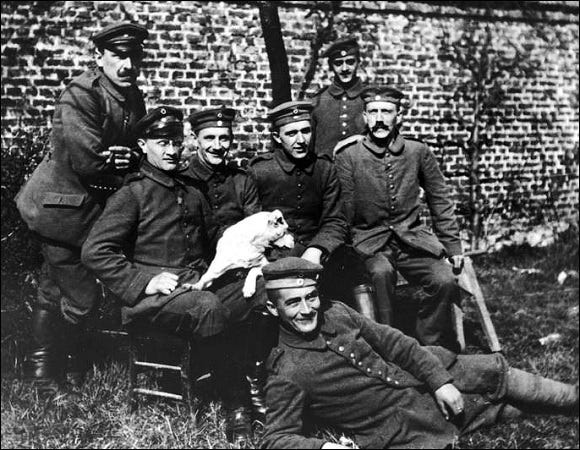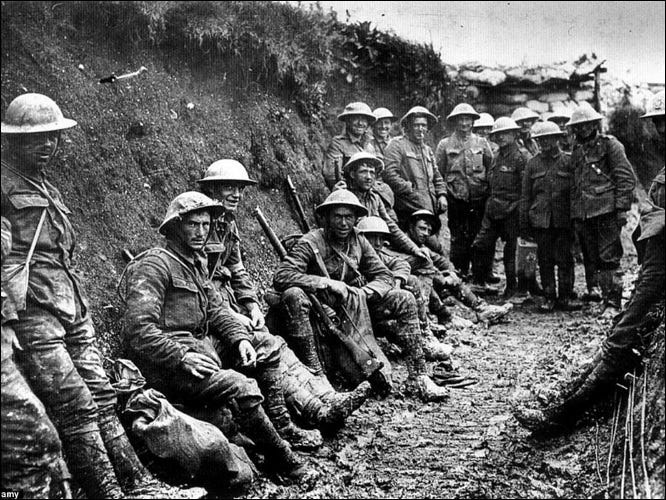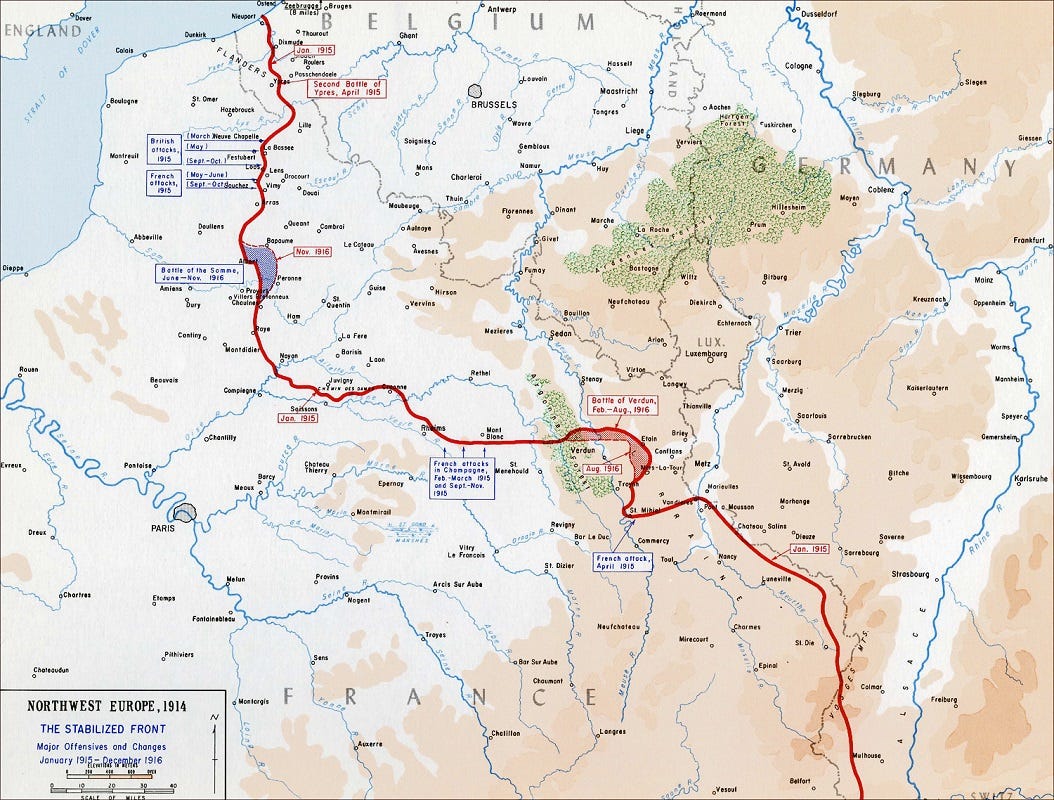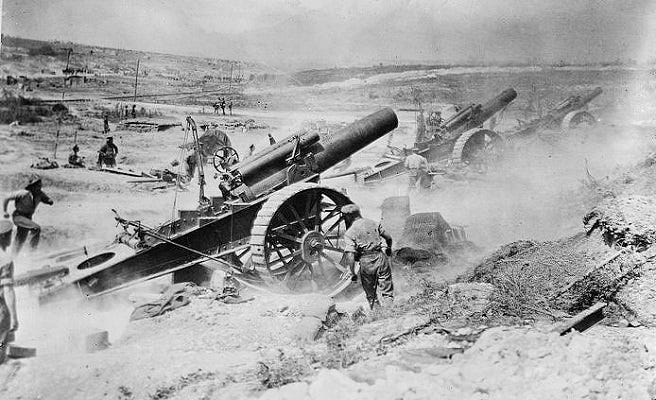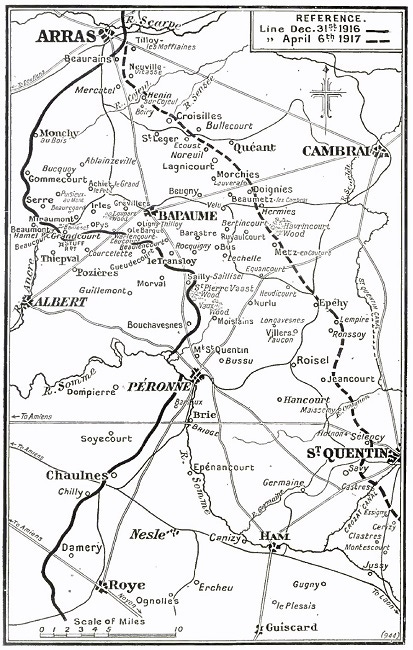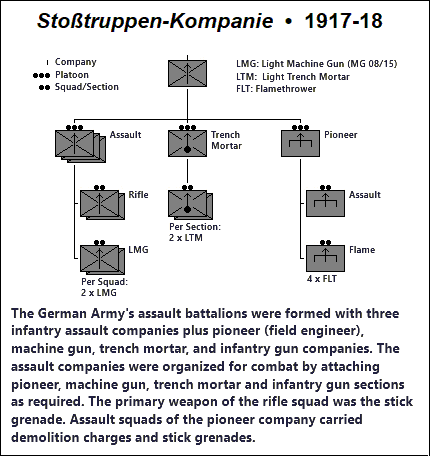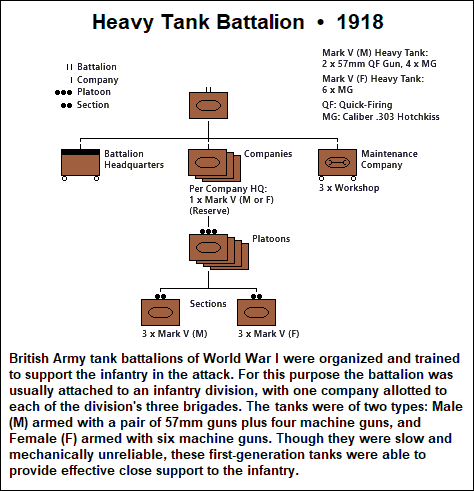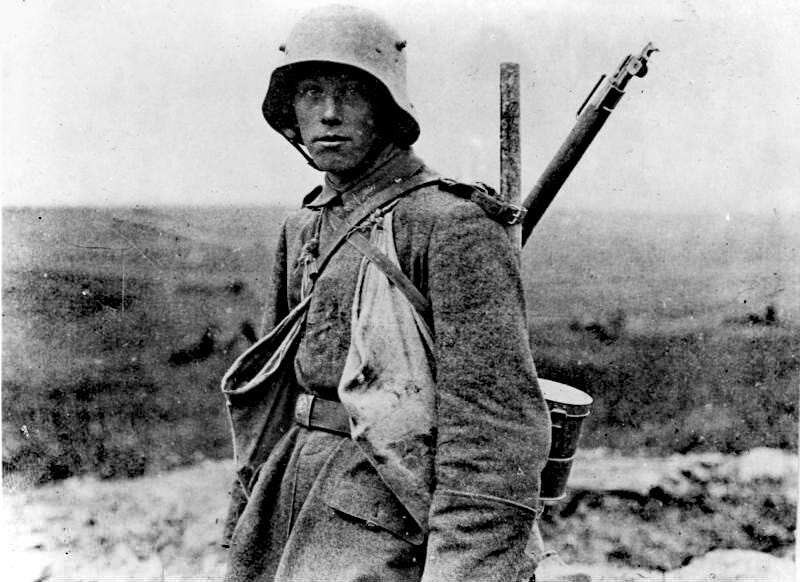
Special Study: Trench Warfare 1914-18
Trench warfare, that enduring symbol of the Great War, was not just a tactical military phenomenon. It was the product of a century of political, economic, social and cultural developments that by transforming Europe also transformed military art and science. And those developments, heralding the advent of modernity, piled up the ingredients of catastrophe.
The rapid growth of Europe's population between 1800 and 1900 provided ample manpower for ever-larger mass armies. The Industrial Revolution spurred the development of new and deadly weapons of war: the magazine rifle, the machine gun and the breach-loaded, recoil-stabilized cannon. Modern methods of administration and finance facilitated national mobilization, enabling the armies to be supplied and maintained in the field indefinitely. Strategic mobility (the ability to move large bodies of troops from area to area) was facilitated by an increasingly dense rail and road net.
But military modernity had its limitations, for once on the battlefield the armies of 1914 were no more mobile than those of the Napoleonic wars, moving on foot or horseback. At the tactical level of warfighting, low mobility and high firepower gave the defender an overwhelming advantage, especially once the armies’ leaders grasped the value of entrenchment. Even the most hastily constructed field fortifications multiplied a soldier’s chances of survival in combat. Inevitably, therefore, the trench systems on both sides grew increasingly elaborate.
Moreover, the rival armies were fighting over the same small area of Western Europe where so many wars of the eighteenth and nineteenth centuries had been fought. But the armies of the Great War were many times larger than those of the Napoleonic Wars, armed with much more lethal weapons, and supported by mobilized industrial economies. The result, as indeed a few military thinkers had foreseen before 1914, was tactical, hence strategic, stalemate.
After the brief period of mobile warfare in 1914, the armies on the Western Front dug in. At first the defenses they constructed were rudimentary: one or two lines of shallow trenches, butressed here and there with sandbags, covered with a narrow belt of barbed wire.
But with the passage of time, trench defenses grew increasingly elaborate. By mid-1915 they usually consisted of a forward line, a support line, and a rear line. The trenches were dug in a zigzag traverse pattern—this to prevent attackers in occupation of one section from firing straight down the trench—with firing steps for riflemen plus protected positions for machine guns and observers. Dugouts in the rear face of each trench provided accommodation for company and battalion headquarters, supply dumps, and shelter from artillery bombardment. The front-line trench was protected by barbed-wire entanglements many yards deep; the support line and the rear line trenches served as assembly points for reserves and fallback positions for the front-line troops. The three trench lines were connected to one another and to the rear area by communications trenches, enabling troops and supplies to be moved back and forth without exposure to enemy observation and fire.
Behind the trench lines were troop billets, artillery positions and brigade headquarters. Farther back still were the division and corps headquarters, large supply dumps, rest camps, field hospitals—all the infrastructure required to support modern armies. Infantry battalions typically rotated between the trenches, the billets and the rest camps. In sectors where an offensive was to take place, the rear areas became crowded with reserve formations and vast quantities of supplies, especially the hundreds of thousands of rounds of artillery ammunition necessary to support or resist the “big push.”
Senior commanders on both sides recognized the inherent power of trench defenses, but that did not lead them to conclude that offensive action was futile. No sooner had trench stalemate appeared than the search was on for some means of overcoming it, and the most obvious solution seemed to be firepower.
The generals reasoned that with enough artillery the enemy’s trench defenses could be demolished, opening a way to the green fields beyond and a war of movement. The costly and unsuccessful Allied offensives on the Western Front in 1915 and 1916, culminating with the horrific Battle of the Somme, only served to confirm their view. The attacks, it was argued, had failed because the supporting artillery was insufficient. More was needed, much more: enough guns and shells to physically annihilate the enemy’s defense system in the sector of the attack.
In fact, however, the French and British generals had misdiagnosed the problem that confronted them.
It was certainly possible to break into the enemy's defenses, capturing a few lines of trenches, and indeed this happened quite often. But it proved extraordinarily difficult to convert such a break-in into a full breakthrough. One obvious problem was that the laborious preparations for a major attack were easy to detect, so that the element of surprise was lacking. Forewarned, the defender had ample time to reinforce the threatened sector. And once the offensive began, the attacking troops of the first wave could be expected to do no more than make good the break-in—an effort that would decimate and exhaust them. The transition to a full breakthrough required the commitment of reserves—and the defender’s advantage in the management of reserves was the real reason for the costly failure of all offensives attempted by the Allies between 1914 and 1917.
On the side of the attacker, before sending their reserves forward the generals at division, corps and army headquarters needed accurate information from the front-line units: Where had the attack succeeded; where had it failed? But such information was slow to arrive. The primitive radios of the day were too cumbersome to carry forward with the attacking troops, telephone lines were all too easily cut by shellfire, messengers could be killed, wounded, or simply become lost. And when accurate information finally did come to hand, the attacker’s reserves had to struggle forward over ground devastated by prolonged artillery bombardment. Meanwhile, the defender could shift reserves quickly by road and rail to the threatened sector of his front. For both sides the battle became a race against time—a race that the defender usually won.
But if the attacker suffered heavy casualties for nugatory gains, it was also true that the price of a successful defense was high. Holding the front-line trenches meant packing them with troops—who, therefore, were exposed to the full fury of the attacker’s preparatory bombardment. The Battle of the Somme in the summer of 1916 is remembered as a disaster for the British Army; less often remarked upon is its effect on the German defenders. The precise toll on the German side is still a matter of some dispute, but a figure of 500,000 total casualties cannot be far from the mark. Toward the end of the battle, reports reaching OHL (the Supreme Command) indicated that the Somme defenses were close to collapse, the trench system itself in poor condition, the troops manning it worn out and dispirited.
The Germans thus realized that a new scheme of defense was required, and with characteristic efficiency they set about creating one that proved highly effective in the conditions prevailing on the Western Front. Having studied the tactical lessons of the Russo-Japanese War (1904-05), the Germans had long since recognized the value of field fortifications, and they took advantage of wartime experience to further refine their methods.
The new defensive system that the German Army developed in 1916-17 was not based on strongly garrisoned linear trenches. The forward line of defense was now an outpost position, lightly held, whose function was to identify the attacker’s axis of advance and slow him down. The troops manning this line occupied small dugouts, sited to take advantage of natural terrain features, and connected to the rear area by communications trenches.
The main defensive zone was based on a series of mutually supporting strongpoints, held in platoon or company strength, covering all avenues of approach. These strongpoints were constructed of steel-reinforced concrete, making them invulnerable to all but a direct hit by heavy artillery. Advancing through this zone, the attacking infantry would find themselves exposed to withering rifle and machine gun fire, supplemented by pre-registered artillery and mortar barrages. Throughout the defensive zone, barbed-wire entanglements and other obstacles were sited to slow the enemy down and prolong his exposure to the defenders’ fire. The depth of the main defensive zone varied from three to four and a half miles, depending on the terrain.
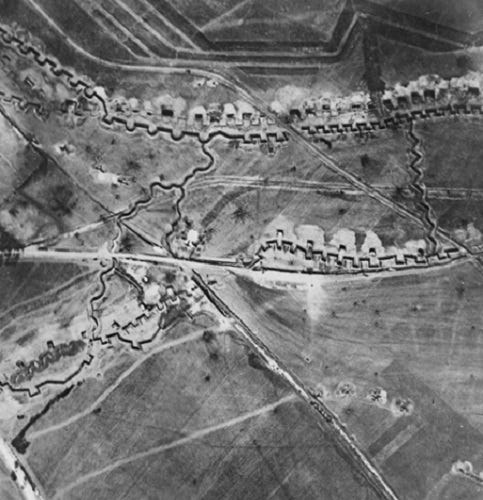
Behind the main defensive zone, the Germans positioned local reserves, usually in company or battalion strength, whose task was to launch immediate counterattacks against any enemy troops who threatened to capture ground essential for the maintenance of the defense. Finally, there was the general reserve: so-called relief divisions (Ablösungsdivisionen), standing by in readiness to mount a full-scale counterattack if necessary.
To streamline command and control, the front was divided into sectors, in each of which a corps headquarters was made responsible for administrative and logistical support. Divisions were rotated in and out of these sectors as necessary, with tactical control devolved upon regimental and battalion commanders (Kampftruppenkommandeur) in the battle zone. These commanders were given discretion to maneuver their troops as necessary to deliver local counterattacks or evade enemy fire.
Further enhancing the effectiveness of their defensive system, the Germans were usually willing to yield ground that might be difficult to defend, siting their positions on the most advantageous terrain. In 1917 they even carried out a large-scale withdrawal from the Somme to the Siegfriedstellung (Siegfried Position), called the Hindenburg Line by the Allies. This position, which became the keystone of the German defenses on the Western Front, embodied all the principles mentioned above and took five months to construct. Though senior commanders were by no means agreed as to the advisability of abandoning the Somme line, the course of the battle from September to November seemed to leave no other option. In March 1917, therefore, the withdrawal to the Siegfriedstellung, code-named Alberich Bewegung (Operation Alberich) after the evil dwarf in the Nibelungenlied, was carried out in good order. It shortened the German line by some 25 miles, enabling a dozen divisions to be taken out of the front as reserves.
Similar defensive positions were established for other sectors of the front in preparation for the anticipated defensive battles of 1917, for instance the Flandernstellung in Belgium. The new system of defense proved highly effective, frustrating the French and British offensives on the Aisne and in Flanders. Though they scored some tactical successes in the former offensive the French were unable to achieve a breakthrough, and they suffered 350,000 casualties against 163,000 inflicted on the Germans—a crushing disappointment that touched off a large-scale mutiny in the ranks of the French Army. In Flanders, the Third Battle of Ypres ended on a similar note of frustration.
After the period of mobile warfare at the beginning of the war, the Germans were quicker than their opponents to recognize the futility of the “big push.” Only at Verdun in 1916 did they conduct a large-scale offensive, and this was conceived as an attrition battle who objective was to wear down the French Army, not to score a major breakthrough. But in late 1917, with Russia effectively defeated, the German high command returned to the idea with which it had commenced the war: the strategy of annihilation. Victory was to be secured by a great offensive that would smash the Allied armies and terminate the war on terms dictated from Berlin.
In 1918 the trench deadlock on the Western Front was finally broken, first by the German Army's new tactics for the attack (the hurricane artillery bombardment, specially trained assault troops, combined-armed battle groups), then by the Allies’ employment of the tank on a large scale against an exhausted enemy. In both cases, the effect was to restore tactical battlefield mobility. But though a few visionary military thinkers perceived that those final battles heralded another revolution in the art of war, the memory of the Western Front’s blood-soaked, trench-scarred battlefields remained dominant in the minds of soldiers, politicians and the European peoples for the next twenty years. One of them was a German soldier who’d served in the trenches for four years, and who on Armistice Day was lying in a military hospital, having been blinded by mustard gas. His name was Adolf Hitler.
